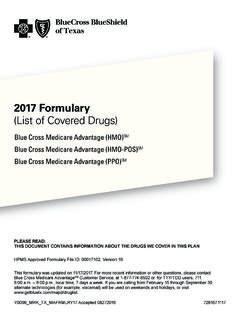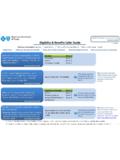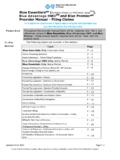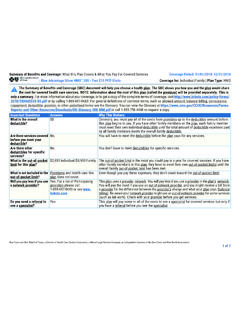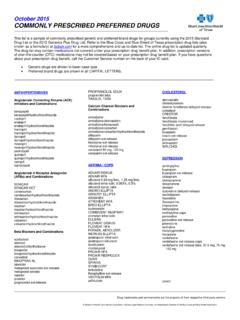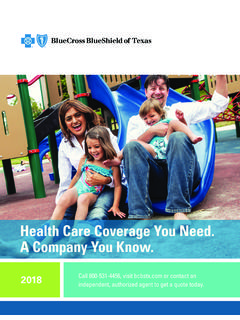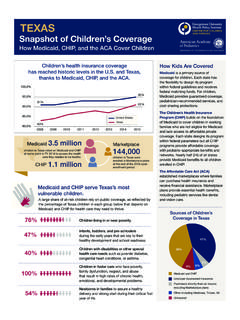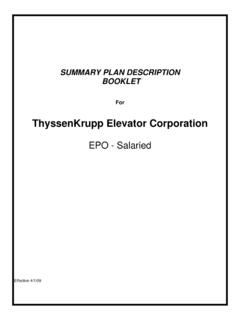Transcription of 2017-2018 Preventive Care Guidelines Table of …
1 1 Divisions of Health Care Service Corporation, a Mutual Legal Reserve Company, an Independent Licensee of the Blue Cross and Blue Shield Association 2017-2018 Preventive Care Guidelines Table of Contents I. Introduction 2 Important Considerations 3 II. Preventive Health Guidelines for Children Age Birth to 18 Years 3 Part I: Neonates (Birth to 1 Month) 3 Part II: Children Age 1 Month to 18 Years- Average Risk Pediatric Population 4 Part III: Recommendations for Select Populations at Risk 7 III. Preventive Health Guidelines for Adults 18 Years and Older 7 Part I: Adults at Average Risk 7 Part II: Recommendations for Select Adult Populations at Increased Risk 10 Part: III: Additional Recommendations for Adults Age 65 and Older IV.
2 Women needing Perinatal Care Part I: Preconception Part II: Prenatal Part III: Postpartum 11 12 12 13 15 V. Immunization Schedules 16 Childhood: 0 to 18 Years 16 Catch-up Schedule: 4 Months to 18 Years 17 Childhood: 0 to 18 Years Footnotes Childhood: Optimized Done By One Schedule (NM) 18 22 Adult: Over 18 Years 24 Adult: Footnotes 26 VI. References and Links to Websites 28 2 Divisions of Health Care Service Corporation, a Mutual Legal Reserve Company, an Independent Licensee of the Blue Cross and Blue Shield Association Introduction Blue Cross and Blue Shield of Illinois, Blue Cross and Blue Shield of Montana, Blue Cross and Blue Shield of New Mexico, Blue Cross and Blue Shield of Oklahoma, and Blue Cross and Blue Shield of Texas ( the Plans ) publish and disseminate evidence-derived Preventive Care Guidelines ( Guidelines )
3 Based upon the recommendations of recognized sources such as professional medical associations, specialty societies, professional consensus panels, national task forces, and governmental entities. The Guidelines are designed to improve physician/practitioner awareness of (and compliance with) effective clinical Preventive care, to improve patient education and to increase the percentage of members who receive recommended clinical Preventive care services. The Guidelines do not cover all possible circumstances, but should be considered a summary of basic Preventive services for these populations: 1.
4 Children from birth to 18 years 2. Adults 19 years and older 3. Adults 65 years and older 4. Women needing perinatal care The Guidelines are focused upon primary prevention; that is, strategies that have been shown to reduce the likelihood of future adverse outcomes in individuals prior to the onset of symptomatic disease. Services such as immunizations, education and counseling, and screening tests are primary Preventive services. The Guidelines apply to average risk, asymptomatic and otherwise healthy individuals. Preventive care interventions appropriate for those with other levels of risk (increased or decreased) will vary by individual circumstance, and physicians/practitioners are encouraged to tailor the approach to these patients as necessary.
5 For certain increased risk groups, additional Guidelines have been included to assist physicians/practitioners. Expert groups may disagree on certain Preventive interventions, and as a consequence, recommendations regarding Preventive services are not always identical. Despite this disparity, there are numerous areas where consensus exists, allowing for the formulation of this set of Guidelines . Whenever possible, the Guidelines follow the recommendations of the United States Preventive Services Task Force (USPSTF) that are considered recommended ( A and B level recommendations).
6 When USPSTF recommendations do not provide sufficient guidance, the Plans, with input from network providers, have adopted the recommendations of other professional organizations that evaluate the value of clinical Preventive services. The Guidelines represent a minimal set of recommended Preventive health services. Additional interventions may be indicated, except where there is a specific recommendation against routine screening. Individual considerations for a given patient should dictate clinical decisions. In addition, physicians/practitioners are encouraged to review the USPSTF statements regarding services that are should not be routinely used (level D ).
7 These are available at: The following points should be emphasized when using the Guidelines : o Unless specified, Guidelines are meant to apply to average risk, asymptomatic and otherwise healthy individuals. Preventive care interventions appropriate for those with other levels of risk (increased or decreased) will vary by individual circumstance, and physicians are encouraged to tailor the approach to these patients as necessary. o The interventions listed are minimal Guidelines . Additional interventions may be useful. o The Guidelines are designed to assist clinicians by providing a guide to clinical Preventive care that is usually appropriate, and are not intended to replace a clinician s judgment, establish a protocol for all patients, or define standards of practice.
8 The final decision regarding medical treatment, including Preventive care services, is made by the physician and the patient. 3 Divisions of Health Care Service Corporation, a Mutual Legal Reserve Company, an Independent Licensee of the Blue Cross and Blue Shield Association o The Guidelines document is not a statement of coverage. Coverage is based upon member eligibility, the member s specific benefit plan design, and state or federal law. There is substantial variation in coverage between benefit programs, and inclusion of a service in the Guidelines does not imply that the service is necessarily a covered benefit and does not guarantee payment.
9 O Because the Guidelines summarize a large amount of information, all details cannot be provided. The practitioner is, therefore, encouraged to review the original sources for more complete discussion of indications and contraindications for specified Preventive care services, and to verify the accuracy of the summary. o Sources are cited for each guideline. Where possible, the exact recommendation of the source is used. In some cases, the recommendation, or its periodicity, has been modified to resolve conflicting recommendations by various sources, or to facilitate practical usage of the guideline in clinical practice settings.
10 O This material is provided for informational purposes only and is not intended to be a substitute for the sound independent medical judgment of health care practitioners. Health care providers are instructed to exercise their independent medical judgment based on the patient s individual medical circumstances including, but not limited to symptoms, history, family history and other factors. The final decision about whether a particular service or treatment should be rendered is between the health care provider and the member (patient). The fact that a particular medical service is listed in this document is not a guarantee that benefits are available for such service.
